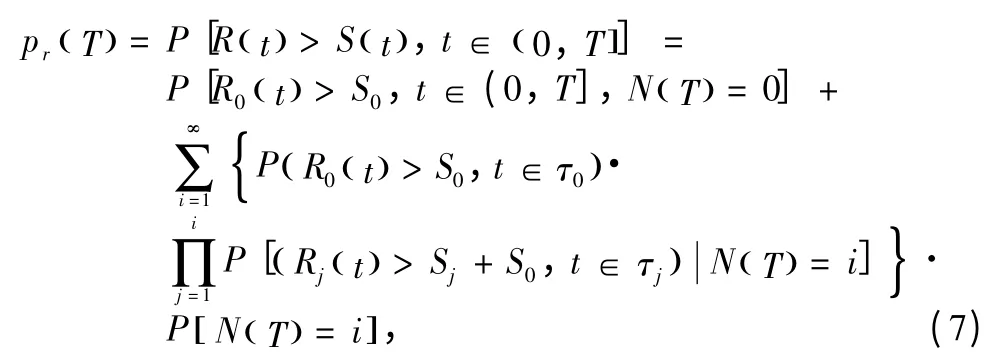Stress-Strength Structural Reliability Model with a Stochastic Strength Aging Deterioration Process
2014-12-20YEHuanCHENQinghua陈庆华
YE Huan (叶 欢),CHEN Qing-hua (陈庆华)
School of Mathematics and Computer Science,Fujian Normal University,Fuzhou 350007,China
Introduction
The structural reliability is an important indicator to evaluate the structural performance.But researching structure's reliability with time-dependent is very difficult,because the deterioration process of strength is uncertain over the life of a structure.The uncertainty in the deterioration process was modeled by a probability distribution of the damage growth rate in Ref.[1].A characteristic feature of this model,also denoted by the Brownian motion with drift as in Ref.[2],is that a structure's strength alternately increases and decreases,like the exchange-value of a share.So,the Brownian motion is inadequate in modeling deterioration which is monotone.In order to incorporate a monotonic increase in deterioration with time,Abdel-Hammeed[3]was the first to propose the gamma process as a proper model for deterioration occurring randomly in time and called this stochastic process the“gamma wear process”.Van Noortwijk[4]proposed the gamma process as an ideal alternative.The stochastic gamma process model,accounting for both populations (i.e.,sampling)and temporal variability associated with a degradation process that typically increased the probability of failure with the aging of a structure,was presented in Ref.[5].A method,peaks-over-threshold method,was proposed in Ref.[6]to combine the two stochastic processes of deteriorating strength denoted by the gamma process and load for computing the time-dependent reliability of a structure.While those papers only talk about the deterioration of structure itself;that is to say,they only take into account the internal deterioration of the structure.
But in fact,in structural engineering,the deterioration is caused by both continuous deterioration over time owing to wear,fatigue,corrosion,crack growth,erosion,consumption,creep,swell,degrading health index,etc.,and instantaneous damage as a result of randomly variable loads.So,we consider that the total deterioration of structure's strength should be the sum of the deterioration owing to continual wear and the abrupt deterioration as a result of randomly variable loads.In other words,the total deterioration of structure's strength should be influenced by both the internal deterioration owing to direct wear and the external deterioration due to randomly variable loads.Peng et al.[7]considered this ideal that was used in the system reliability and maintenance modeling.This ideal that was used in the k-out-of-n systems reliability and multi-component systems reliability and maintenance modeling,was extended in Refs.[8-9].Wang et al.[10]proposed a general degradation modeling framework for hybrid deterioration systems,which were made up of both linear and nonlinear degradation parts,by employing an additive Wiener process model that consisted of a linear degradation part and a nonlinear part.There are some other researches using this ideal in system reliability.But,they are all about system reliability.As we all known that structural reliability and system reliability are two different branches of the reliability theory.Moreover,we solve this strength deterioration model by the common stress-strength interference theory,which is used to solve engineering structural reliability questions.So,this research is very meaningful for evaluating the structure performance.
1 Model Description
1.1 Model assumption
The assumptions that are used for the reliability in this paper are summarized as follows.Meanwhile,the particular assumptions will be explained in the corresponding sections.
(1)Randomly variable loads,which produce the stress,occur according to a Poisson process.Sjfor j = 1,2,…,∞are used to denote the sizes of loads themselves,which are i.i.d random variables.Yjfor j = 1,2,…,∞are used to define the damage sizes as a result of the jth variable load,which are also i.i.d random variables.Moreover,S0is used to denote the value of structure's permanent load that does not produce abrupt damage to the strength,and is a constant and equal to s.
(2)We suppose that Sj,Yj,and β for j = 1,2,…,∞are independent of each other.
(3)We also assume that the initial value of structure's strength,R0,is a constant and equal to r.Moreover,r is much larger than α + s and α is the initial value of the continuous deterioration.
1.2 Stochastic structural load process
Statistical descriptions of structural loads are essential ingredients for structural reliability analysis.Events giving rise to significant structural loads occur randomly in time and are random in their intensity.Just as Mori et al.[11]said that the load intensity varied negligibly or slowly during the interval in which it occured,its effect on the structure was essentially instantaneous.In this model,the total number of randomly variable loads that have occurred in time interval 0,( ]t is a homogeneous Poisson process with the intensity λ.The sizes of the jth variable load arriving at tjis denoted as Sjfor j = 1,2,…,∞,which are i.i.d random variables.In addition,FS( s)and fS( s)are the CDF and PDF of Sj.According to the Poisson model,the probability that the number of load events,N()t ,which is equal to n within the interval 0,( ]t ,can be written as:

Thus,the stochastic load process is given as Poisson square wave process[12].That is to saysatisfies the following conditions:
(1){ τj,j = 0,1,2,…,∞ }are sequence time intervals included in the time interval ( 0,t ].Here,we make τj=( tj,tj+1],for j = 0,1,…,N(t)and t0= 0,tN(t)+1= t.
(2) {Sj,j = 1,2,…,∞ }are assumed to be i.i.d random loads time sequence.
(3) {N( t),t ≥0 }is a homogeneous Poisson process with the intensity λ.
(4)N( t)and {Sj,j = 1,2,…,∞}are independent of each other for all t ≥0.At the same time,

1.3 Stochastic structural strength deterioration process
In fact,in structural engineering,the total deterioration of structure's strength,Xr( t),should be the sum of internal deterioration owing to continual wear and the external deterioration as a result of randomly variable loads.The deterioration owing to continual wear over time,X( t),may follow one of the various deterioration models,such as a linear deterioration model with random coefficients (as in Refs.[13-14]) or a randomized logistic deterioration model[15].Naturally,it can be a stochastic process such as gamma process,too.In this paper,a linear deterioration model is used to model continuous deterioration over time due to wear,X()t = α + βt,where the initial value α and the deterioration rate β can be constants or random variables as in Ref.[7].In this paper,we consider the initial value α and the deterioration rate β to be positive random variables.
At the same time,deterioration changes or shifts can increase instantaneously when a randomly variable load occurs.The instantaneous increases in the total deterioration are measured by the randomly variable load damage sizes,which are supposed to be i.i.d random variables and signed as Yjfor j = 1,2,…,∞.The cumulative damage size due to randomly variable loads until time t is given as compound Poisson process[12].So {Z( t),t ≥0 }meets the following conditions:
(1) {Yj,j = 1,2,…,∞}are assumed to be i.i.d random time sequence.
(2) {N( t),t ≥0 }is a homogeneous Poisson process with the intensity λ.
(3)N( t)and {Yj,j = 1,2,…,∞ }are independent of each other for all t ≥0.At the same time,

where N()t is the total number of randomly variable loads that have occurred in time interval 0,( ]t .The total deterioration of structural strength is denoted as Xr()t = X()t + Z()t .So the probability that the total deterioration of structure's strength at time t is less than x derived in Ref.[7],


Furthermore,if we consider G x,()t to be the cdf of X()t at t,fY( y)to be the pdf of Yj,and( y)to be the pdf of the sum of M i.i.d Yjvariables,then the cdf of Xr()t in Eq,(4)can be derived using a convolution integral:

2 Structural Reliability Analysis
In structural reliability theory,the stress-strength structural model is such important that many researchers have used this model to solve many engineering structural problems.Generally,it is assumed that strength and stress are random variables.Thereby,the structural reliability is represented by[12]:

where FS()s and fS()s are the cdf and pdf of the stress S,and FR()r and fR()r are the cdf and pdf of the strength R.
But,more generally,stress and strength may be stochastic processes.At this concept,aforementioned researchers have done many papers.We suppose that randomly variable loads,which produce the stress,occur at random times according to a Poisson process.Thereby,the reliability,pr( T),defined as the probability of that the structure is reliable during the time interval 0,( ]T ,is expressed as:

where T is the design service period of the structure,

Furthermore,if we suppose that Hj( x,t)is the cdf of
By using Eqs.(4)-(5),then,Eq.(7)can be derived for the general case as:

3 An Example with the Specific Distribution
If we assume that the randomly variable load damage sizes and loads themselves are all i.i.d normal random variables,Yj~Nand Sj~N.Meanwhile,we suppose the continuous deterioration follows a linear model with a positive constant initial value α and a normal-distributed deterioration rate β,β ~NOn the basis of the 3σ principle of normal distribution,we should choose the proper μβto ensure β >0 with probability close to 1.
From the above part,combining of Eq.(6),we can get:

Thus,based on the general case in Eq.(7),combining of Eqs.(11)-(12),then the structural reliability for the more specific case,pr()T ,can be expressed as:

where Φ()· is the cdf of a standard normally distributed variable.
4 Conclusions and Future Research Needs
In this paper,a stress-strength structural reliability model with a stochastic strength aging deterioration process is presented.Here,the deterioration of structure's strength should be influenced by both the internal deterioration owing to direct wear and the external deterioration due to randomly variable loads.Meanwhile,the load process is given as Poisson square wave process.The reliability is derived by stress-strength interference theory.So,this model is proper for the evalution of structural reliability in realistic structural engineering.In future studies,parameter estimation should be done and a stochastic process model can be used to model the continuous deterioration.Moreover,this paper talks about only one structural component,and we can also extend to multi-structural components.
[1]Mori Y,Ellingwood B R.Maintaining:Reliability of Concrete Structures.I: Role of Inspection/Repair [J].Journal of Structural Engineering,1994,120(3):824-845.
[2]Karlin S,Taylor H M.A First Course in Stochastic Processes[M].2nd ed.San Diego:Academic Press,1975.
[3]Abdel-Hammeed M.A Gamma Wear Process [J].IEEE Transactions on Reliability,1975,24(2):152-153.
[4]Van Noortwijk J M,Kok M,Cook R M.Optimal Maintenance Decisions for the Seabed Protection of The Eastern-Scheldt Barrier[C].Proceedings of Engineering Probabilistic Design and Maintenance for Flood Protection,Dordrecht,1997:25-56.
[5]Van Noortwijk J M,Pandey M D.A Stochastic Deterioration Process for Time-Dependent Reliability Analysis [C].Proceedings of the 11th IFIP WG 7.5 Working Conferenc on Reliability and Optimization of Structural Systems,London,2004:259-265.
[6]Van Noortwijk J M,van der Weide J A M,Kallen M J,et al.Gamma Processes and Peaks-over-Threshold Distributions for Time-Dependent Reliability [J].Reliability Engineering and System Safety,2007,92:1651-1658.
[7]Peng H,Feng Q M,Coit D M.Reliability and Maintenance Modeling for Systems Subject to Multiple Dependent Competing Failure Processes[J].IEEE Transactions,2011,43(1):12-22.
[8]Song S L,Chatwattanasiri N,Coit D M,et al.Reliability Analysis for k-out-of-n Systems Subject to Multiple Dependent Competing Failure Processes [C].Proceedings of Quality,Reliabiltiy, Risk, Maintenance, and Safety Engineering(ICQR2MSE), 2012 International Conference on, IEEE Transactions,2012:36-42.
[9]Song S L,Coit D M,Feng Q M,et al.Reliability Analysis for Multi-component Systems Subject to Multiple Dependent Competing Failure Processes [J].IEEE Transactions on Reliability,2014,63(1):331-345.
[10]Wang Z Q,Hu C H,Wang W B,et al.An Additive Wiener Process-Based Prognostic Model for Hybrid Deterioration Systems[J].IEEE Transactions on Reliability,2014,63(1):208-222.
[11]Mori Y,Ellingwood B R.Time-Dependent System Reliability Analysis by Adaptive Importance Sampling [J].Structural Safety,1993,12(1):59-73.
[12]Lin Z M.Reliability Design and Estimation of Engineering Structure[M].Beijing:China Communications Press,1990.(in Chinese).
[13]Christer A H,Wang W.A Model of Condition Monitoring of a Production Plant[J].International Journal of Production,1992,30:2199-2211.
[14]Lu C J,Meeker W Q.Using Degradation Measures to Estimate a Time-to-Failure Distribution[J].Technometrics,1993,35:161-174.
[15]Li W,Pham H.Reliability Modeling of Multi-state Degraded Systems with Multi-competing Failures and Random Shocks[J].IEEE Transactions on Reliability,2005,54(2):297-303.
杂志排行
Journal of Donghua University(English Edition)的其它文章
- Condition-Based Maintenance Decision-Making for Equipment
- Settlement Prediction of Dredger Fill with the Optimal Combination Model
- Identification of the Credit Guarantee Network of Steel Trade Enterprises in China
- Methods for Reliability Assessment under Irregular Time-Varying-Stress Degradation Testing
- Effect of Starch Dodecenylsuccinylation on the Adhesion and Film Properties of Dodecenylsuccinylated Starch for Polyester Warp Sizing
- Reliability Allocation of Large Mining Excavator Electrical System Based on the Entropy Method with Failure and Maintenance Data
